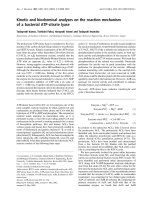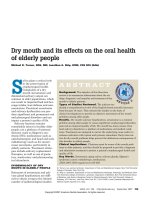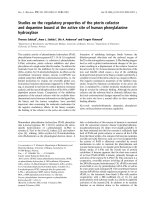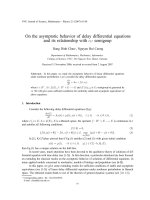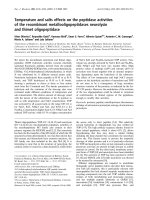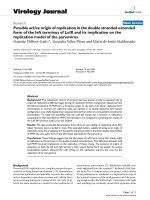Experimental and numerical studies on the viscoelastic behavior of living cells
Bạn đang xem bản rút gọn của tài liệu. Xem và tải ngay bản đầy đủ của tài liệu tại đây (3.22 MB, 191 trang )
EXPERIMENTAL AND NUMERICAL STUDIES ON
THE VISCOELASTIC BEHAVIOR OF LIVING CELLS
ZHOU ENHUA
NATIONAL UNIVERSITY OF SINGAPORE
2006
EXPERIMENTAL AND NUMERICAL STUDIES ON
THE VISCOELASTIC BEHAVIOR OF LIVING CELLS
ZHOU ENHUA
(B.Eng., WUHEE & M.Eng., WHU)
A THESIS SUBMITTED
FOR THE DEGREE OF DOCTOR OF PHILOSOPHY
DEPARTMENT OF CIVIL ENGINEERING
NATIONAL UNIVERSITY OF SINGAPORE
2006
Acknowledgements
This thesis involves the collaborative efforts of many people, to which I am
grateful. First and foremost, I would like to thank my thesis advisors Prof. QUEK
Ser Tong and Associate Prof. LIM Chwee Teck. I appreciate Prof. Quek’s relentless
effort in helping me to improve scientific thinking and writing as well as his
kindness in allowing me ample freedom in pursuing my research interest. Prof. Lim
introduced me to the exciting field of bioengineering. I am particularly grateful to
his encouragement, inspiration and humor, which make my PhD research full of fun
and high spirits.
The experimental work in this thesis could not have been accomplished
without the full support from the Nano Biomechanics Lab (Division of
Bioengineering) led by Prof. Lim, which provided excellent facilities and financial
resources. I would like to thank all the colleagues in the lab: VEDULA S.R.K., LI
Ang, FU Hongxia, Gabriel LEE, Eunice TAN, HAIRUL N.B.R., Kelly LOW,
ZHANG Jixuan, Gregory LEE, LIU Ying, QIE Lan, CHENG Tien-Ming (National
Taiwan University), Ginu UNNIKRISHNAN (Texas A & M University), John
MILLS (MIT), TAN Lee Ping, CHONG Ee Jay, LI Qingsen, JIAO Guyue, SHI Hui
and NG Sin Yee for stimulating discussions, warm friendship and many other helps.
I am grateful to Abel CHAN, Brian LIAU (Johns Hopkins University), Anthony
LEE, NG Shi Mei, Ammar HASSANBHAI, Kelvin LIM and YONG Chee Kien for
technical assistance in the experiments.
My sincere thank goes to the Department of Civil Engineering for providing
a comfortable and vibrant research environment. I thank my colleagues in the
ii
department: DUAN Wenhui, TUA Puat Siong, LI Zhijun, MA Yongqian, VU Khac
Kien, LUONG Van Hai, PHAM Duc Chuyen, SHAO Zhushan, CHEN Zhuo, SHEN
Wei, Kathy YEO, Annie TAN and Mr. SIT Beng Chiat for interesting discussions
and valuable support.
I would like to thank Prof. Jeffrey FREDBERG, Dr. Guillaume
LENORMAND, Dr. DENG Linhong, and many other future colleagues at Harvard
School of Public Health for sharing their knowledge on soft glassy rheology of cells.
I am particularly thankful to Prof. Fredberg for sponsoring me to attend a workshop
on cell mechanics at Harvard in 2005.
I want to thank my colleagues in Biochemistry Lab, Division of
Bioengineering: Prof. Seeram RAMAKRISHNA, YANG Fang, XU Chengyu, HE
Wei, Thomas YONG, Karen WANG, Satinderpal KAUR and many others for
allowing me to use their facilities and helping me with cell culture and confocal
microscopy. I would also like to thank Dr. CHAI Chou (Johns Hopkins Singapore)
for helping me with cytoskeleton staining and TAY Bee Ling (Department of
Biological Sciences) for helping me with the fabrication of glass micropipettes. I am
indebted to Prof. KOH Chan Ghee, Prof. James GOH, Prof. Somsak
SWADDIWUDHIPONG, Prof. Dietmar HUTMACHER and many other NUS
lecturers for sharing their knowledge and enthusiasm in scientific research with me.
NUS generously provided me with research scholarship, to which I am
indeed grateful. I am more than grateful to the unconditional love and persistent
support from my parents, my wife and other family members. Thank you!
iii
Table of Contents
Acknowledgements i
Table of Contents iii
Summary viii
List of Tables x
List of Figures xi
List of Symbols xiv
Chapter 1 Introduction 1
1.1 Structure of eukaryotic cells 2
1.2 Viscoelastic properties of cells 4
1.3 Finite element modeling of cell deformation 7
1.4 Objectives and scope of work 8
1.5 Organization 9
Chapter 2 Literature Review on Cell Mechanics 11
2.1 Experimental techniques in cell mechanics 13
2.2 Mechanical models for eukaryotic cells 16
2.2.1 Overview 16
2.2.2 Cortical shell-liquid core models 17
2.2.2.1 Newtonian liquid drop model 17
2.2.2.2 Shear thinning liquid drop model 21
2.2.2.3 Maxwell liquid drop model 25
2.2.3 Spring-dashpot smear models 27
2.2.3.1 Linear elastic solid model 28
2.2.3.2 Standard linear solid model 31
iv
2.2.3.3 Standard linear solid-dashpot model 33
2.2.4 Power-law rheology model 35
2.2.5 Summary 40
Chapter 3 Experimental Setup and Procedures 42
3.1 Micropipette aspiration technique 42
3.1.1 Fabrication of glass micropipettes and chambers 42
3.1.2 Temperature control 43
3.1.3 Setup of the hydrostatic loading system 43
3.1.4 Testing procedures 45
3.1.5 Accuracy in the measurement of pressure and time 46
3.2 Cell culture 47
3.3 Drug treatments 47
3.4 Staining of actin filaments 48
Chapter 4 Micropipette Aspiration of Fibroblasts – Ramp Tests and
Effects of Pipette Size 49
4.1 Introduction 49
4.2 Experimental results 51
4.2.1 Effect of pipette size on cell deformation 52
4.2.2 Apparent deformability measured with large pipettes 56
4.2.3 Stress-free projection length measured with large pipettes 59
4.2.4 Ramp-test results for 1/120 cmH
2
O/s 61
4.3 Discussion 64
4.3.1 Blebbing and nonlinear deformation preferentially occur
with smaller pipettes 64
4.3.2 Larger pipettes are more suitable for probing
smeared mechanical properties of cells 65
4.3.3 Rate dependence of measured deformability 67
v
4.3.4 Calculation of deformed projection length 67
4.3.5 On approximate applicability of linear viscoelasticity to cells 68
Chapter 5 Micropipette Aspiration of Fibroblasts – Creep Tests and
Power-law Behavior 71
5.1 Introduction 71
5.2 Experimental results 73
5.2.1 Creep behavior of untreated fibroblasts 73
5.2.1.1 Interpretation and modeling of creep function 74
5.2.1.2 Statistical distribution of the power-law parameters 77
5.2.1.3 Effect of pipette size on creep function 79
5.2.2 Effect of drug treatments 80
5.3 Discussion 84
5.3.1 Power-law behavior of creep function and its dependence on
pipette edge effect 84
5.3.2 Compatibility between creep tests and ramp tests 86
5.3.3 Mechanical properties of fibroblasts – a comparison with
others’ work 88
5.3.4 A general trend for power-law rheology of cells 90
5.3.5 High reproducibility and low variability of
the current measurement 92
5.3.6 Effect of actin cytoskeleton disruption 95
5.3.7 Effect of microtubule cytoskeleton disruption 97
5.4 Conclusions 99
Chapter 6 Finite Element Simulation of Micropipette Aspiration
Based on Power-law Rheology 101
6.1 Introduction 101
6.2 Material constitutive relations 103
6.2.1 Neo-Hookean elasticity 103
vi
6.2.2 Power-law rheology approximated by Prony series expansion 104
6.3 Finite element model based on power-law rheology 106
6.3.1 Basic assumptions 106
6.3.2 Geometric description of micropipette aspiration 106
6.3.3 Boundary and loading conditions 107
6.3.4 Finite element mesh 108
6.4 Results 108
6.4.1 Elastic deformation 109
6.4.2 Creep deformation 112
6.4.2.1 Prony-series approximation of power-law rheology and
simple shear test 112
6.4.2.2 Power-law behavior of simulated creep deformation 114
6.4.2.3 Effect of
α
on B
FE
and
β
FE
117
6.4.2.4 Effect of pipette geometry on B
FE
and
β
FE
119
6.4.2.5 Comparison between experiments and simulation 121
6.4.3 Ramp deformation 124
6.4.3.1 Effect of loading rate and
α
on C
FE
125
6.4.3.2 Effect of pipette geometry on C
FE
127
6.4.3.3 Comparison between experiments and simulation 128
6.5 Discussion 130
6.5.1 Interpretation of G(1) and
α
using FE simulation results 131
6.5.2 Departure from linear viscoelasticity and
correspondence principle 132
6.5.3 Comparison with others’ work on FE simulation of
micropipette aspiration using other rheological models 134
6.5.4 Potential application in studying mechanotransduction 135
vii
Chapter 7 Conclusions and Future Work 138
7.1 Conclusions 138
7.2 Future work 140
References 142
Appendix A Reported Mechanical Properties of Cells
Based on Three Models 155
Appendix B Linear Viscoelasticity 160
B.1 Linear viscoelasticity based on fractional derivatives 160
B.2 Derivation of the complex modulus 161
B.3 Derivation of power-law rheology model from
the fractional derivative viscoelasticity 162
B.4 Power-law rheology model and the correlation between
complex modulus, creep function and relaxation modulus 163
B.5 Elastic-viscoelastic correspondence principle 165
B.6 Derivation of ramp-test response in micropipette aspiration
from power-law creep function 166
B.7 Power-law dependence of apparent deformability on
loading rate in ramp tests 167
Appendix C Prony Series Approximation of Power-law Rheology 169
Appendix D Curriculum Vitae 170
viii
Summary
Mechanical forces and deformation are among the key factors influencing
the physiology of cells. How cells move, deform, and interact, as well as how they
sense, generate, and respond to mechanical forces are dependent on their mechanical
properties and these properties need to be studied and understood. Micropipette
aspiration has been widely used to measure the viscoelasticity of cells in suspension,
which has generally led to the development of spring-dashpot models. However,
recent experiments performed on attached cells using other techniques strongly
supported the power-law rheology model, which may potentially serve as a general
model for cell rheology. Yet, this model has not been experimentally proven for
suspended cells.
In this dissertation, the micropipette aspiration technique was used to
investigate the rheology of suspended NIH 3T3 fibroblasts with the aim of
investigating whether the power-law rheology model also applies to cells in
suspension. In the ramp tests, cells were subjected to linearly increasing suction
pressure using pipettes of different diameters. The pipette diameter was found to
have a significant effect on cell deformation, where for diameters smaller than ~ 5
μm, nonlinear and inconsistent deformations were observed but for diameters larger
than ~ 7 μm, deformation of the cells was found linear and consistent. Therefore,
larger pipettes are more applicable than smaller ones for measuring the smeared
rheology of NIH 3T3 fibroblasts.
In the creep tests, cells were subjected to a step pressure applied using large
pipettes. The power-law rheology model was found to accurately fit the creep
ix
functions of suspended fibroblasts, providing new support to this model for
suspended cells. Effect of cytoskeleton disruption on rheological properties was
investigated. Disruption of actin filaments with cytochalasin D caused cells to
appear softer but more elastic. In contrast, disruption of microtubules with high
dosage of colchicine caused activation and stiffening of cells.
Finite element method is an established and versatile engineering tool,
particularly suited for the continuum mechanical analysis of cell deformation.
However, a finite element model that incorporates the power-law rheology of cells
was not available. Here, a finite element model incorporating the power-law
rheology of cells was proposed. The initial-boundary-value problem of micropipette
aspiration was solved numerically. Using consistent rheological properties, this
model could predict the experimental observations obtained using both creep and
ramp tests for suspended NIH 3T3 fibroblasts. The finite element simulation
revealed departure from the half-space solution as a result of (i) finite cell radius
with respect to pipette radius, (ii) large deformation and (iii) slippage. Approximate
formulae were proposed based on simulation results, which allow direct
interpretation of rheological properties of cells in micropipette aspiration.
It is hoped that the experimental methodology and theoretical model
proposed in this thesis will contribute to a more accurate evaluation of the
viscoelastic properties of healthy and diseased cells and better understanding of the
biological response of cells to mechanical stimuli.
x
List of Tables
4.1 Measured mechanical properties of cells with ramp tests 67
6.1 B
FE
for
α
= 0 ~ 0.4, e
*
= 0.06 and R
p
*
= 0.25 ~ 0.6 120
6.2 Summary of FE simulation results 130
A.1 Reported mechanical properties for Newtonian liquid drop model 155
A.2 Reported mechanical properties for standard linear solid model 156
A.3 Reported mechanical properties for power-law rheology model 157
C.1 Prony-series coefficients for fitting power-law rheology model 169
xi
List of Figures
1.1 The structure of a eukaryotic cell 3
2.1 Experimental techniques for cell mechanics 14
2.2 The first experimental setup of micropipette aspiration 15
2.3 An overview of mechanical models for living cells 16
2.4 Deformation of a cell in micropipette aspiration 18
2.5 The Newtonian liquid drop model 18
2.6 Modeling the micropipette aspiration of neutrophils with CSLC models 20
2.7 The shear thinning liquid drop model 23
2.8 The Maxwell liquid drop model 25
2.9 The homogeneous standard linear solid (SLS) model 32
2.10 The SLS-D model 34
2.11 Modeling oscillatory twisting cytometry of human airway
smooth muscle cells 38
3.1 Glass chamber for containing cell sample 42
3.2 Experimental setup for micropipette aspiration 44
3.3 Measurement of pipette diameter and cell deformation in
micropipette aspiration 45
4.1 Deformation of cells during ramp tests with micropipette aspiration 53
4.2 Effect of pipette size on ramp-test results 54
4.3 Dependence of measured deformability on pipette size 57
4.4 Fitting ramp-test data with half-space model and elastic FE model 58
4.5 Dependence of measured stress free projection length on pipette diameter 60
4.6 Determination of pipette entrance location 61
4.7 Effect of pipette size on ramp-test results at 1/120 cmH
2
O/s 62
xii
4.8 Dependence of measured deformability on pipette size at 1/120 cmH
2
O/s 63
5.1 Creep deformation of fibroblasts measured by micropipette aspiration 74
5.2 Average creep function of suspended fibroblasts plotted in log-log scale 75
5.3 Fitting average creep function of suspended fibroblasts by three models 76
5.4 Statistical distribution of the power-law rheology (PLR) parameters 78
5.5 Effect of pipette size on the measured creep function 80
5.6 Effect of drug treatments on cell deformation during creep experiments 81
5.7 Power-law behavior of average creep functions after drug treatments 82
5.8 Effect of drug treatments on power-law coefficients 83
5.9 Fitting the L
p
G
-based creep function with PLR and SLS-D models 86
5.10 Predicting the ramp-test deformation based on the creep-test results 87
5.11 Difference in actin cytoskeleton for attached and suspended fibroblasts 90
5.12 Comparison of the PLR parameters reported with different
experimental techniques 91
5.13 Effect of cytoD on the rheological properties and actin cytoskeleton of
NIH 3T3 fibroblasts 96
6.1 Schematic of micropipette aspiration of a cell 106
6.2 An axisymmetric finite element (FE) model for a spherical cell 108
6.3 Geometric comparison of the FE model with the half-space model 109
6.4 Effect of pipette radius on elastic force-deformation relationship 110
6.5 Dependence of
0
FE
C
α
=
on R
p
*
for elastic FE analysis (
α
= 0) 111
6.6 Fitting power-law relaxation modulus with 5-term Prony
series expansion 113
6.7 Comparison of FE-computed creep functions at different stress levels
with analytical prediction for
α
= 0.3 114
6.8 Evolution of
L
p
/R
p
with time for different power-law exponents (
α
) 115
6.9 Fitting simulated creep deformation with power-law function 116
xiii
6.10 Effect of
α
on
β
FE
and B
FE
118
6.11 Effect of pipette radius on B
FE
and
β
FE
120
6.12 Effect of fillet radius on B
FE
and
β
FE
121
6.13 Comparison of deformed cell shapes between simulation and
experiments for a creep test at ΔP = 100 Pa 122
6.14 Comparison between experiments and simulation for creep tests 123
6.15 Typical pressure-deformation relationship in a simulated ramp test 124
6.16 Effect of loading rate on C
FE
for different
α
126
6.17 Effect of
α
on C
FE
, as modulated by the loading rate 127
6.18 Effect of pipette radius and fillet radius on C
FE
, as modulated by
α
for
P
v
Δ
= 10/3 Pa/s 128
6.19 Comparison of deformed cell shapes between simulation and
experiments for a ramp test with
P
v
Δ
= 10/3 Pa/s 129
6.20 Comparison of apparent deformability between experiments and
simulation for ramp tests at two loading rates: 10/3 Pa/s and 5/6 Pa/s 129
6.21 Three-level hierarchical approach to investigating mechanotransduction
of single cells 137
B.1 The correlation between complex modulus, creep function and
relaxation modulus for the power-law rheology model 165
xiv
List of Symbols
A
G
Magnitude of complex modulus at
ω
= 1 rad/s for the PLR model
A
J
Creep compliance corresponding to t = 1 s for the PLR model
b
Power for shear thinning fluid
B
Left Cauchy-Green strain tensor
B,
β
Power-law scaling factor and exponent for experimentally measured
creep deformation
B
H-S
,
β
H-S
Power-law scaling factor and exponent for creep deformation, based on
the half-space solution
B
FE
,
β
FE
Power-law scaling factor and exponent for creep deformation, based on
the FE simulation
FE
C Average slope of L
p
/R
p
against ΔP/G(1) derived from FE simulation of
power-law rheology model
0
FE
C
α
=
Average slope of L
p
/R
p
against ΔP/G(1) derived from FE simulation of
elastic model
d
Lateral bead translation in MTC
e
Fillet radius of pipette
e
*
Fillet radius scaled by cell radius
E
Young’s modulus
f
Frequency (in Hz)
F
Force of indentation
F
0
, A
F
Average force and amplitude of oscillatory AFM indentation
F
Deformation gradient
G
Elastic shear modulus
G(t) Relaxation shear modulus
()
*
G
ω
Complex shear modulus
xv
G′, G′′ Dynamic storage and loss shear moduli
G
0
, ω
0
Scaling factors for stiffness and frequency for PLR model
H(t) Heaviside function
I
Unit tensor
I
1
Deviatoric strain invariant
J(t) Creep function
J
FE
(t) FE-computed creep function
J
0
, t
0
Scaling factors for creep compliance and time for PLR model
k
Elastic constant for Maxwell model
k
1
, k
2
Elastic constants for SLS and SLS-D models
L
p
Deformed projection length of a cell
L
p
T
Total projection length measured for a cell
L
p
SF
Stress-free projection length of a cell measured with ramp tests
L
p
G
Stress-free projection length of a cell estimated from geometry
P
cr
Critical suction pressure
R
Radius of the bead in MTC
R
c
Radius of a cell
R
I
Radius of a plane-ended cylindrical indenter
R
p
Inner radius of a pipette
R
p
*
Pipette radius scaled by cell radius
R
2
Pearson product moment correlation coefficient
S
Slope of the ΔP-L
p
T
relation measured in a ramp test
t
Time
T
Specific mechanical torque applied per unit bead volume in MTC
T
0
Static cortical tension
xvi
U
Neo-Hookean strain energy density function
u
Displacement field tensor
v
Velocity field tensor
P
v
Δ
Loading rate in a ramp test
*
P
v
Δ
Loading rate for which C
FE
is independent of
β
′
FE
x, X Tensors for current and initial configurations in elastic deformation
x(
t) Tensor for the configuration at time t in viscoelastic deformation
α
Exponent of the power-law rheology model
α
MMTC
Geometric coefficient for magnetic MTC
α
OMTC
Geometric coefficient for optical MTC
β
′
FE
Magnitude of the average slope of
10
log
FE
C versus
10
log
P
v
Δ
at a given
α
γ
Engineering shear strain in simple shear
c
γ
Characteristic shear rate for shear thinning fluid
m
γ
Mean shear rate for shear thinning fluid
p
γ
Instantaneous shear rate at a point for shear thinning fluid
γ
Engineering strain tensor
γ
Strain rate tensor
Γ(·) Gamma function
δ
Depth of indentation
δ
0
, A
δ
Average depth and amplitude of oscillatory AFM indentation
ε
Difference between L
p
SF
and L
p
G
ΔP
Total suction pressure
ΔP
*
Dimensionless suction pressure, ΔP/G(1)
η
Apparent viscosity for shear thinning fluid
xvii
η
c
Characteristic viscosity for shear thinning fluid
θ
Inclination angle of a pyramid-shaped indenter
κ
Shape factor for bead geometry in MTC
λ
1
,
λ
2
,
λ
3
Principal stretches at x, y and z directions
µ
Shear viscosity for Newtonian fluid or viscous constant for spring-
dashpot models
μ
0
Viscous constant for SLS-D model
ν
Poisson’s ratio
σ
Total Cauchy stress tensor
τ
Engineering shear stress in simple shear
τ
Deviatoric part of Cauchy stress tensor
φ
Angle of bead rotation in MTC
Φ
P
Geometric constant for the half-space model
ψ
Phase lag in an oscillatory test
ω
Angular frequency (in rad/s)
Chapter 1 Introduction
All living organisms are under the influence of forces. Scientific
investigation on the response of biological tissues to mechanical forces has began
since as early as in the 17
th
century, when Galileo Galilei (1564-1642) examined the
strength of bones and Robert Hooke (1635-1703) investigated the elasticity of a
number of biological materials. It was only in the mid 1960’s that modern
biomechanics began to evolve with the development of continuum mechanics,
computing technologies and systematic testing of biological tissues ranging from
hard tissues such as bones to soft tissues such as blood vessels (Fung 1993;
Humphrey 2003).
A major thrust of biomechanics research is to promote better understanding
of physiology and pathophysiology, as pointed out by Fung (1993). To this end,
study on single cells is important because they are the basic units of life (Alberts et
al.
2002). Cells generate forces to migrate, contract, divide and perform
phagocytosis, blood cells are subject to deformation during circulation and neural
cells respond to mechanical stimuli in hearing and touch. Also mechanical forces are
known to regulate cell shape, migration, gene expression and even apoptosis.
Therefore, cell mechanics investigates “how cells move, deform, and interact, as
well as how they sense, generate, and respond to mechanical forces” (Zhu et al.
2000).
Cell mechanics was first pioneered by the experimental works of Crick and
Hughes (1950), who probed the cytoplasm of fibroblasts with magnetic beads, and
Mitchison and Swann (1954), who tested sea-urchin eggs with micropipette
Chapter 1 Introduction 2
aspiration. Early attempts before 1980’s were comparatively sparse and mainly
focused on structurally simple cells, such as sea urchin eggs and red blood cells
(RBCs). Thereafter, more systematic investigation were made on cell mechanics,
exemplified by the burgeoning of various innovative experimental techniques on
different types of cells and the development of a series of important theoretical
works and mechanical models (Zhu et al. 2000; Kamm 2002; Bao and Suresh 2003;
Lim
et al. 2006).
1.1 Structure of eukaryotic cells
Typical eukaryotic animal cells are made of 70 ~ 85% of water and 10 ~
20% of proteins, with the rest being lipids, polysaccharides, RNA, DNA and small
metabolites (Alberts et al. 2002). The major functional units of a cell are
compartmentalized into various membrane-enclosed organelles, including the
nucleus (Fig. 1.1). These organelles are dispersed in the cytoplasm, which is
spanned by a system of protein filaments collectively called the cytoskeleton. The
cytoskeleton provides a three-dimensional (3D) scaffold for the spatial organization
of the organelles (Pangarkar et al. 2005; Dinh et al. 2006). There are mainly three
types of cytoskeletal filaments: actin filaments, microtubules and intermediate
filaments. The actin filaments (also called microfilaments) are two-stranded helical
polymers with a diameter of 8 nm, mainly distributed close to the cell cortex. The
microtubules, hollow cylinders with a diameter of 25 nm, irradiate from the center of
the cell into the cytoplasm. The intermediate filaments are ropelike fibers with a
diameter of around 10 nm, found throughout the cytoplasm and also within the
nuclear envelop. The various cytoskeletal elements are crosslinked into a network by
Chapter 1 Introduction 3
various accessory proteins. However, the cytoskeleton is not a static structure. It
undergoes constant remodeling and is capable of moving and contracting due to the
action of motor proteins and the dynamic assembly and disassembly of the
cytoskeletal polymers.
Fig. 1.1. The eukaryotic cell is composed of a cell membrane, a cytoplasm (which includes
the cytosol, cytoskeleton and various suspended organelles) and a nucleus (which houses the
genetic materials) (Lim et al. 2006).
The cytoskeleton serves a wide range of functions, one of the most important
of which is to provide mechanical strength to the cells. In fact, the mechanical
properties of the cells are predominantly determined by the cytoskeleton. This was
demonstrated firstly by the fact that cytoskeletal networks reconstituted in vitro can
approximately replicate mechanical properties of cells (Janmey et al. 1994; Gardel
et al.
2006) and secondly, by the observation that disrupting the cytoskeletal
Golgi
apparatus
endoplasmic
reticulum
nucleus
mitochondrion
cell membrane
comprising the
phospholipid bilayer
actins
intermediate
filaments
centrosome
microtubule
Chapter 1 Introduction 4
elements such as actin filaments will reduce the stiffness of cells (Petersen et al.
1982; Wakatsuki et al. 2001). Therefore, cytoskeletal abnormalities in the molecular
level may be manifested as changes in the mechanical properties of cells (Elson
1988). Probing the mechanical properties of the cells might contribute to better
understanding, diagnosis, and treatment of relevant diseases such as cancer, malaria,
arthritis and some skin diseases (Nash et al. 1989; Ward et al. 1991; Fuchs and
Cleveland 1998; Trickey
et al. 2000; Guck et al. 2005; Suresh et al. 2005).
1.2 Viscoelastic properties of cells
Quantification of the mechanical properties of cells has been intensely
pursued in the past few decades (Bao and Suresh 2003; Lim et al. 2006). Based on
the concept of continuum mechanics, the properties of cells are widely expressed in
mechanical terms such as the Young’s modulus, viscosity, storage modulus and loss
modulus. Various experimental techniques and mechanical models have been
developed to measure these properties and will be reviewed in detail in Chapter 2.
Unlike some common engineering materials, the cells are neither fluid-like or solid-
like, but exhibit strong viscoelastic behavior. If a constant force is imposed, the cells
will creep whereas if a constant deformation is applied, the resisting force of the
cells will relax over time. Therefore, the mechanical properties of cells can only be
accurately described when the viscoelasticity of cells is taken into account properly.
The cytoskeleton is a highly conserved structure (Mitchison 1995) and is
qualitatively similar across different nucleated animal cell types (Alberts et al. 2002).
Thus, one would expect the cytoskeleton of different nucleated animal cell types to
have qualitatively similar passive viscoelastic behaviors. Furthermore, the generic
Chapter 1 Introduction 5
behavior of the cytoskeleton deformation should not depend on the measuring
techniques. Therefore, it would be desirable to have a general viscoelastic model
which can cover as many cell types as possible and as many experimental techniques
as possible. Such a general model will potentially identify common features of
cytoskeleton deformation and reveal the physical state of the cytoskeleton (e.g. as
soft glass or as gel) (Fabry et al. 2001a; Bursac et al. 2005). In addition, having a
general model will standardize the interpretation of mechanical properties and will
allow the comparison of mechanical moduli across different cell types and across
different experimental techniques.
Micropipette aspiration had been widely used to perform creep tests on
neutrophils, chondrocytes, endothelial cells and fibroblasts in suspension (Schmid-
Schonbein et al. 1981; Evans and Kukan 1984; Evans and Yeung 1989; Sato et al.
1990; Ward et al. 1991; Tsai et al. 1993; Sato et al. 1996; Thoumine and Ott 1997a;
Jones et al. 1999b; Thoumine et al. 1999; Trickey et al. 2000; Trickey et al. 2004).
Most of the spring-dashpot viscoelastic models were proposed in the context of this
technique and had widely been used for many other types of experiments (Lim
et al.
2006). However, several recent experiments performed over a wide range of cell
types and organelles strongly supported the power-law rheology model (Fabry
et al.
2001a; Alcaraz et al. 2003; Lenormand et al. 2004; Yanai et al. 2004; Balland et al.
2005; Dahl et al. 2005; Desprat et al. 2005). These latest experiments generally
involved improved resolution in terms of time, frequency, and deformation
measurement. Thus, the power-law rheology model could be a promising candidate
for a general model of cell rheology. Yet, this model has not been confirmed with
Chapter 1 Introduction 6
micropipette aspiration for single cells, which is the basis for other competing
models based on the spring-dashpot concept.
In addition, most of the experiments that supported the power-law rheology
model were performed on cells adherent to the substrate (or glass microplates in the
case of microplate manipulation (Desprat et al. 2005)), with the exception of
micropipette aspiration of the nuclei (Dahl et al. 2005). The power-law rheology
model has not been proven for suspended eukaryotic cells. The rheology of cells in
suspension becomes interesting especially when one considers the transport and
trapping of white blood cells or metastatic cancer cells in the capillaries (Worthen et
al.
1989; Yamauchi et al. 2005). If proven valid, the power-law rheology model will
provide a common platform for comparing the rheological properties of both
adhered and suspended eukaryotic animal cells.
Lastly, probing adherent cells in suspension may lead to more consistent
measurement of the passive mechanics of the cells. It is well known that most
anchorage-dependent cells develop stress fibers and contractile stress (or prestress)
while adherent to a substrate. The stiffness of the substrate influence the prestress
(Discher et al. 2005; Saez et al. 2005), which in turn will modulate the stiffness and
rheology of the cells (Wang et al. 2002; Stamenovic et al. 2004). For the purpose of
measuring the passive rheological behavior of the cell, detaching and suspending the
cells will result in less internal active prestress and potentially allow more consistent
measurement of the passive mechanics of the cells, as shown by the optical stretcher
experiments (Guck et al. 2005; Wottawah et al. 2005).


